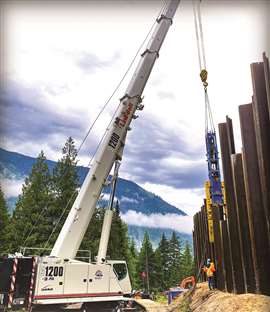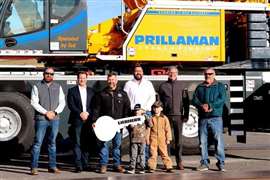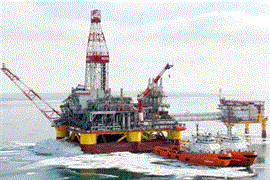Friday round up: Tower cranes, TopLift 2024 and telecrawlers
03 October 2024
 Photo: Link-Belt Cranes
Photo: Link-Belt Cranes
Another week of Crane & Transport Briefing is in the books. We hope everyone has been enjoying our daily updates, because there’s plenty more exclusive content headed to your inbox.
The week kicked off discussing a hot button topic—using batteries instead of diesel generators to help power construction sites, and tower cranes in particular. Construction contractor Bowmer & Kirkland in the UK has already gone as far as adopting battery energy storage systems as its preferred method for powering cranes, even discovering that entire sites can be powered by a single battery.
Mark your calendars! The annual contest to find the favourite lifting project from the last 12 months is open for voting. The 2024 IC TopLift returns with what have been selected as being the top ten lifts reported in the last 12 months of International Cranes and Specialized Transport and-or on Crane & Transport Briefing.
Wednesday’s Briefing rounded up the most noteable acquisitions of 2024 so far. It has been a year of transformative change for the crane and specialized transportation sector, with mergers and acquisitions dominating the headlines. Most recently, the acqusition of Manitex International by Tadano shook up the space.
Hannah Sundermeyer also dove into the telescopic crawler crane market. While the market for telecrawlers has remained steady, manufacturers are seeing a surge in demand for higher-capacity models. She reached out to the five conventional telecrawler manufacturers for their take on the market and information about their leading models.
In more detail
Number crunching: batteries and tower cranes
Using batteries instead of diesel generators to help power tower cranes is already the preferred method for one UK contractor, writes Phil Bishop.
On the £130 million (US$170 million) Echo Street project in Manchester, northern England, contractor Bowmer & Kirkland is using an Enertainer L+ battery energy storage system to power two Terex CTL 180 luffing jib tower cranes, two twin hoists and currently 11 – but at peak will be 33 – mast-climbing work platforms (MCWPs). The battery is also powering site offices, lighting and anything else that needs electricity
.In addition to the environmental benefits, simple economics have led to this shift in favour of batteries. Scrapping tax relief on diesel in the UK in 2022 immediately doubled or even tripled the price of fuel used by conventional generators.
Running the Echo Street site on diesel generators would require 429,000 litres a year so over the two year build, at the UK price per litre, it would work out around £1.45 million. A conservative calculation of the equivalent electricity cost would be around £50,000 a year, so £100,000 for the whole job. That leaves a good chunk to go towards renting or buying a battery unit.Read more about the financial and environmental benefits of battery power.
Read more about the financial and environmental benefits of battery power.
TopLift competition 2024: vote for your favourite lift
Our annual contest to find the favourite lifting project from the last 12 months is ready for your vote. Our 2024 IC TopLift returns with what we have selected as being the top ten lifts reported in the last 12 months of International Cranes and Specialized Transport and-or on Crane and Transport Briefing,
Check out the brief summaries and the full stories too, if you’d like more detail before you make your choice, then fill in the all-important voting form for your favourite lift and submit it to us as soon as possible. Your vote is much appreciated.
Read more about the 2024 IC TopLift contest and cast your vote today.
Revisiting the most impactful acquisitions of 2024 so far
2024 has been a year of transformative change for the crane and specialized transportation sector, with mergers and acquisitions dominating the headlines. These major transactions are not just reshaping individual companies but are poised to influence industry rankings like the IC100, ACT100, IC Transport 50 and ACT Transport 50.
From Barnhart’s aggressive expansion with several key acquisitions across the U.S. to the $1.1 billion deal that saw TFI International acquire Daseke, the sixth-largest specialized transport company globally, the sector is undergoing rapid consolidation. Other significant moves include Denzai KK acquiring fellow lifting and transport specialist Kurogane Corporation in Japan, and Japanese crane maker Tadano Ltd finalizing the purchase of Manitex International.
These transactions highlight a growing trend towards consolidation as companies strive to increase market share, expand geographical reach and offer more comprehensive services. Whether it’s the integration of major players or niche companies expanding their offerings, these moves are setting the stage for a more competitive and dynamic market.
Take a look at the top crane and specialized transport acquisitions this year.
What’s going on in the telescopic crawler market?
Telescopic crawler cranes are revolutionizing the construction and energy industries, thanks to their notable versatility, ease of transport and ability to perform in challenging environments. These cranes, capable of quickly mobilising across varied terrains, are highly sought after in sectors ranging from highway and bridge construction to powerline maintenance and even wind farm projects.
While the market for telescopic crawler cranes has remained steady, manufacturers are seeing a surge in demand for higher-capacity models. Companies like Link-Belt, Liebherr, Manitowoc and Tadano are innovating and expanding their product lines to meet the growing need for cranes that can handle larger loads with greater efficiency. For example, Link-Belt’s TCC-2500, a 250-ton crane, has been instrumental in large-scale green energy projects, while Liebherr’s LTR 1150 brings new technology to the table with its VarioBase system, enhancing both safety and performance in high-wind conditions.
As the construction landscape evolves, telescopic crawler cranes are becoming essential tools for projects that require both power and precision. The Crane & Transport Briefing team reached out to the five conventional telecrawler manufacturers for their take on the market and information about their leading models.
Read more about the latest telecrawlers diversifying today’s market.
All the above stories were featured in KHL’s new Crane and Transport Briefing in the week beginning 30 September.



